May 04, 2025
Invitation
Michigan Event
Steve Goreham and Dr. Calvin Beisner will be speaking in Grand Rapids the evening of Friday, May 23, from 7-10 PM Eastern time. The topic will be:
Climate Change: Fact or Fantasy?
Location: GR.Church, 4525 Stauffer Avenue, Grand Rapids, MI 49508
Tickets and Information

Please buy tickets and plan to attend if you are in the area.
----------
Below are two recent articles.
Time to Defund the Climate Models?
Published in MasterResource, April 29, 2025.
Climate models have been the basis for concern about climate change for more than 35 years. The US government, the United Nations, and organizations across the world have used model projections to warn about global warming and to demand a shift to renewable energy. But Trump administration budget cuts at NASA, NOAA, and other federal agencies threaten to shut down the models, the heart of climate change alarmism.
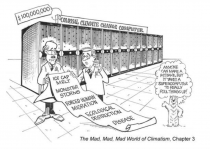
Cartoon of men holding a sign in front of lockers
US Military Exits Climate Change after a Decade of Waste.
Published in MasterResource, April 2, 2025.
The United States military has pursued an increasing number of programs to try to fight climate change for more than a decade. The air force, army, and navy each developed programs to use alternative energy and to reduce hydrocarbon-based fuels, with aggressive carbon dioxide (CO2) emissions reduction plans. But under the Trump Administration, climate change mitigation will no longer be an objective of the US military.
A logo of a navy ship

Globally warm regards,
Steve
Steve Goreham
stevegoreham.com
815-275-9532
Feb 26, 2025
RGGI more than doubles electrical costs for residents and all consumer sectors
Joseph D’Aleo ICECAP
First the softsell
Greenhouse Gas Initiative
The Regional Greenhouse Gas Initiative (RGGI) is a cooperative effort among eleven Eastern states to reduce carbon dioxide (CO2) emissions from power plants within each participating state.Together, the participating states have established a regional cap on CO2 emissions, which sets a limit on the emissions from regulated power plants within the RGGI states.
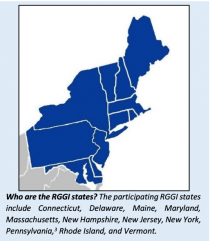 Enlarged Enlarged
When you list the states with the highest electricity prices for the residential sector, the list has the RGGI states and no surprise California.
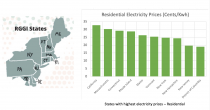 Enlarged Enlarged
The lowest prices were in statesnd that have common sense energy policies.
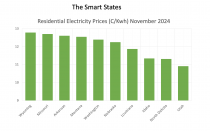 Enlarged Enlarged
The same holds for all energy user sectors - first highest prices and then lowest prices.
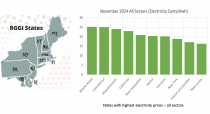 Enlarged Enlarged
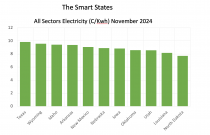 Enlarged Enlarged
The RGGI Fact sheet tries to sell the benefits to the state and users.
Regional Greenhouse Gas Initiative
The Regional Greenhouse Gas Initiative (RGGI) is a cooperative effort among eleven Eastern states to reduce carbon dioxide (CO2) emissions from power plants within each participating state. Together, the participating states have established a regional cap on CO2 emissions, which sets a limit on the emissions from regulated power plants within the RGGI states. Over time, the regional cap declines, so that CO2 emissions decrease in a planned and predictable way.
Since 2005, the RGGI 10 states have reduced annual power sector emissions 50%, which is almost 50% faster than the nation as a whole, and have so far raised over $8.6 billion to invest into local communities. How Does RGGI Work? Within the RGGI states, certain power plants must acquire one RGGI CO2 allowance for every short ton of CO2 they emit. The RGGI states distribute these allowances at quarterly auctions, where they can be purchased by power plants and other entities.
Some states hold a limited number of allowances in set-aside accounts to sell at a fixed price or otherwise distribute outside of the auction process. Once an allowance is distributed, it can be held and traded, which creates a secondary market for allowances.
Feb 20, 2025
70+ scientific papers say: Today’s Sea Level Change Indistinguishable From Noise
Anthony Watts, WUWT
Holocene Sea Levels were 2 Meters Higher
1. Are Modern ‘Anthropogenic’ Sea Levels Rising At An Unprecedented Rate? No.
Despite the surge in CO2 concentrations since 1900, the UN’s Intergovernmental Panel on Climate Change (IPCC) has concluded that global sea levels only rose by an average of 1.7 mm/yr during the entire 1901-2010 period, which is a rate of just 0.17 of a meter per century.
During the 1958 to 2014 period, when CO2 emissions rose dramatically, a recent analysis revealed that the rate of sea level rise slowed to between 1.3 mm/yr to 1.5 mm/yr, or just 0.14 of a meter per century.
Frederiske et al.,2018 “Anthropogenic” Global Sea Level Rise Rate (1958-2014): +0.14 of a meter per century
“For the first time, it is shown that for most basins the reconstructed sea level trend and acceleration can be explained by the sum of contributors, as well as a large part of the decadal variability. The global-mean sea level reconstruction shows a trend of 1.5 +/- 0.2 mm yr−1 over 1958-2014, compared to 1.3 +/- 0.1 mm yr-1 for the sum of contributors.”
2. ~15,000 - 11,000 Years Ago, Sea Levels Rose At Rates Of +4 to +6 Meters Per Century
In the past few thousand years, sea levels in some regions rose and fell at rates of + or - 0.5 to 1.1 meters per century. Sea levels during the Medieval Warm Period were+170 centimeters higher than today.
Hansen et al., 2016 Denmark, +1.7 meters higher than present during the Medieval Warm Period

“Continuous record of Holocene sea-level changes ... (4900 years BP to present). ... The curve reveals eight centennial sea-level oscillations of 0.5-1.1 m superimposed on the general trend of the RSL [relative sea level] curve [relative sea levels ~1.7 m higher than present from 1400 to 1000 years ago].”
Cronin et al., 2017 Global Sea Level Rise Rate: +4 meters per century (14,500 to 14,000 years ago)
“Rates and patterns of global sea level rise (SLR) following the last glacial maximum (LGM) are known from radiometric ages on coral reefs from Barbados, Tahiti, New Guinea, and the Indian Ocean, as well as sediment records from the Sunda Shelf and elsewhere. ... Lambeck et al. (2014) estimate mean global rates during the main deglaciation phase of 16.5 to 8.2 kiloannum (ka) [16,500 to 8,200 years ago] at 12 mm yr−1 [+1.2 meters per century] with more rapid SLR [sea level rise] rates (∼ 40 mm yr−1) [+4 meters per century] during meltwater pulse 14.5-14.0 ka [14,500 to 14,000 years ago].”
Abdul et al., 2017 Global Sea Level Rise Rate: +4 meters per century(11,450 to 11,100 years ago)
“We find that sea level tracked the climate oscillations remarkably well. Sea-level rise was fast in the early Allerod (25 mm yr-1), but decreased smoothly into the Younger Dryas (7 mm yr-1) when the rate plateaued to <4 mm yr-1 here termed a sea-level "slow stand". No evidence was found indicating a jump in sea level at the beginning of the Younger Dryas as proposed by some researchers. Following the "slow-stand", the rate of sea-level rise accelerated rapidly, producing the 14 +/- 2 m sea-level jump known as MWP-1B; occurred between 11.45 and 11.1 kyr BP with peak sea-level rise reaching 40 mm yr-1 [+4 meters per century]."
Ivanovic et al., 2017 Northern Hemisphere Sea Level Rise Rate: +3.5 to +6.5 meters per century (~14,500 years ago)
"During the Last Glacial Maximum 26-19 thousand years ago (ka), a vast ice sheet stretched over North America [Clark et al., 2009]. In subsequent millennia, as the climate warmed and this ice sheet decayed, large volumes of meltwater flooded to the oceans [Tarasov and Peltier, 2006; Wickert, 2016]. This period, known as the "last deglaciation," included episodes of abrupt climate change, such as the Bolling warming [~14.7-14.5 ka], when Northern Hemisphere temperatures increased by 4-5C in just a few decades [Lea et al., 2003; Buizert et al., 2014], coinciding with a 12-22 m sea level rise in less than 340 years [3.5 to 6.5 meters per century] (Meltwater Pulse 1a (MWP1a)) [Deschamps et al., 2012]."
Zecchin et al., 2015 Regional Sea Level Rise Rate: +6 meters per century(14,500-11,500 years ago)
"[M]elt-water pulses have punctuated the post-glacial relative sea-level rise with rates up to 60 mm/yr. [6 meters per century] for a few centuries."
3. Over 70 Papers Affirm Sea Levels Were 2+ Meters Higher Than Now A Few Thousand Years Ago When CO2 Levels Were 'Safe'.
70+ Papers: Sea Levels 2+ m Higher 9,000-4,000 Years Ago While CO2 Levels Were 'Safe' (265 ppm) More Here
Before the advent of the industrial revolution in the late 18th to early 19th centuries, carbon dioxide (CO2) concentrations hovered between 260 to 280 parts per million (ppm).
Within the last century, atmospheric CO2 concentrations have risen dramatically. Just recently they eclipsed 400 ppm.
Scientists like Dr. James Hansen have concluded that pre-industrial CO2 levels were climatically ideal. Though less optimal, atmospheric CO2 concentrations up to 350 ppm have been characterized as climatically “safe”.
However, CO2 concentrations above 350 ppm are thought to be dangerous to the Earth system. It is believed that such “high” concentrations could lead to rapid warming, glacier and ice sheet melt, and a harrowing sea level rise of 10 feet within 50 years.
To reach those catastrophic levels (10 feet within 50 years) predicted by proponents of sea level rise alarmism, the current “anthropogenic” change rate of +0.14 of a centimeter per year (since 1958) will need immediately explode into +6.1 centimeters per year.
The likelihood of this happening is remote, especially considering Greenland and Antarctica combined only contributed a grand total of 1.54 cm since 1958 (Frederiske et al., 2018).
It is becoming more and more apparent that sea levels rise and fall without any obvious connection to CO2 concentrations.
And if an anthropogenic signal cannot be conspicuously connected to sea level rise (as scientists have noted), then the greatest perceived existential threat promulgated by advocates of dangerous man-made global warming will no longer be regarded as even worth considering.
Read more at No Tricks Zone
Feb 05, 2025
Trump Drops a Bomb on Green Energy
By Steve Goreham
Originally published in MasterResource.
President Trump has long been a supporter of traditional energy. During his campaign, he spoke negatively about electric vehicles, wind, and other renewable energy sources. But in his first day in office, the new president began a historic shift in US energy policy, away from green energy and back to hydrocarbon energy.
On January 20, 2025, President Trump signed five wide-ranging executive orders that radically change United States energy and climate policy. These actions restore efforts to promote coal, natural gas, oil, hydropower, nuclear, and biofuels, while curtailing support for wind and electric vehicles. The Trump executive orders also rescinded orders issued by President Biden and closed federal departments established to promote climate change policies and green energy.
The executive order regarding “offshore wind” and “wind projects” immediately impacted the world wind industry. The US government owns all land from three miles to 200 miles offshore, so wind companies require a federal lease to build offshore systems. The order withdrew “all areas within the Offshore Continental Shelf” from wind leasing. The order also requires that the new Secretary of the Interior, Doug Burgum, “conduct a comprehensive review” to determine the necessity for “terminating or amending any existing wind energy leases” and to submit a report to the President. The order also put a hold on the Lava Ridge Wind Project in Idaho, pending a review by the Secretary of the Interior, a project which was approved by the Biden Administration in December.
Wind energy markets were shocked by Trump’s order. The stock price of Orsted, a Danish wind system supplier, dropped 17% to its lowest price in seven years. Orsted proposed to build Sunrise Wind, the largest planned US offshore wind system, to be located southeast of New York City. The company immediately took a $1.69 billion impairment charge on US wind projects.
Wind suppliers RWE of Germany, Equinor of Norway, Renovaveis of Portugal, and Vestas of Denmark also suffered stock price declines. Italy’s Prysmian announced that it would abandon a plan to build a plant in the US to make cables for offshore wind systems.
Wind energy plans for several states have been crippled. California planned to install 25 gigawatts of offshore wind energy by 2045, with initial projects at Morro Bay and Humbolt Bay, but these plans are on hold for at least the next four years. Maryland, Massachusetts, New Jersey, New York, North Carolina, South Carolina, Rhode Island, and Virginia are constructing or planning east coast offshore systems, but these programs will be reviewed, limited, or halted if not yet started.
The “Unleashing American Energy (UAE)” executive order calls for elimination of the “electric vehicle (EV) mandate” to promote consumer choice and access to gasoline-powered automobiles. It’s true that we have no formal EV mandate, but 22 states have zero-emissions vehicle laws or executive orders prohibiting sales of gasoline cars by a future date, typically 2035. On March 20 of last year, the Environmental Protection Agency (EPA) issued updated emissions standards that would force auto manufacturers to sell an increasing number of EVs, rising from about 8% last year to about 56% of new light vehicle purchases by 2032.
A map of the united states with green and white states

The Trump orders also call for termination of state emissions waivers “that function to limit sales of gasoline powered automobiles.” The 1970 Clean Air Act established the federal government as responsible for regulating pollution, except where a waiver is granted by the EPA to a state. For years, California has set emissions standards, receiving EPA waivers to do so, with other states following California’s lead. The orders seek to terminate these waivers to California and restore emissions control to the EPA. Earlier this month, California withdrew their request for a waiver for regulations to electrify heavy trucks and locomotives because it appeared that Trump’s EPA would not grant that request.
The order also calls for the “elimination of unfair subsidies and other ill-conceived government-imposed market distortions that favor EVs.” This probably refers to coming efforts to eliminate the $7500 tax credit on new EV sales and also efforts to eliminate the Corporate Average Fuel Economy standards issued by the Department of Transportation, which force auto manufacturers to sell a larger share of EVs.
The US economy today includes several green energy industries which probably would not exist without the vast array of federal and state subsidies and tax credits. Wind, solar, EV charging, carbon dioxide (CO2) capture, and green hydrogen receive a limitless stream of subsidies and tax credits from the Inflation Reduction Act (IRA) and the Infrastructure Investment and Jobs Act (IIJA), both of which were passed during the Biden Presidency. The CATO institute estimates that renewable energy will receive about $80 billion in federal funds during fiscal year 2025.
During his campaign, Mr. Trump vowed to eliminate the money flow from these two acts, and his first-day executive orders reflect this. The UAE order calls for “termination of the Green New Deal,” and a halt to the disbursement of funds from the IRA and IIJA. President Trump will probably need to pass Congressional legislation to permanently reduce the flow of IRA and IIJA funds.
Wind and solar systems are intermittent, use 100 times the land area, and require at least double the transmission infrastructure compared to traditional coal, gas, or nuclear power plants. Few utilities would build wind and solar systems if not for the fear of human-caused global warming. But the new executive orders make it clear that the US will no longer pursue efforts to “mitigate” climate change.
In the executive order titled “Putting America First in International Environmental Agreements,” the President directs the US Ambassador to the United Nations, nominee Elise Stefanik, to notify the UN in writing that the US withdraws from the Paris Climate Agreement, effective immediately. The order also states that the US will immediately cease financial payments under the Framework Convention on Climate Change.
The orders direct executive branch officials to cancel at least five Biden executive orders on climate change, and to disband the Climate Change Support Office, the American Climate Corps, and The Working Group on the Social Cost of Greenhouse Gases. The orders also call for the EPA to review the 2009 Endangerment Finding for “continuing applicability.” That finding concluded that carbon dioxide endangered US citizens and is the basis for regulating CO2 emissions in the US.
The Trump actions also seek to boost the development of hydrocarbon energy in the spirit of “drill, baby, drill.} Key actions include re-opening the licensing of liquified natural gas terminals, opening federal lands for onshore and offshore oil and gas production, reopening Alaska lands for energy production, and reducing efficiency regulations on dishwashers, stoves, and furnaces. The President also declared a national energy emergency to speed the deployment of pipelines and other energy infrastructure. The Trump EPA and Department of Energy will roll back regulations on oil and gas to expand US production.
Trump’s executive order bomb, followed by Congressional action to limit funds from the IRA and IIJA, promises to gut, or profoundly reshape, the US green energy movement. January 2025 may begin a long decline for green energy and a return to sensible energy policy.
Steve Goreham is a speaker on energy, the environment, and public policy and author of the bestselling book Green Breakdown: The Coming Renewable Energy Failure.
Jan 28, 2025
How To Rescind the Endangerment Finding in a Way That Will Stick
From the MANHATTAN CONTRARIAN
Francis Menton
As discussed in my previous post, one of President Trump’s first-day Executive Orders - the one entitled “Unleashing American Energy” - directed a reconsideration of EPA’s so-called “Endangerment Finding” (EF) of 2009. The EF is the EPA regulatory action where it claimed to determine that CO2 and other “greenhouse gases” qualify as “pollutants” under the Clean Air Act because they are a “danger to public health and welfare.” President Trump’s January 20 EO directs that EPA, within 30 days, submit “recommendations to the Director of OMB on the legality and continuing applicability of the Administrator’s findings.”
Since the EF is the foundation underlying all the Biden-era regulations restricting and suppressing fossil fuels, you can be sure that any attempt to eliminate it will be met with a full-bore litigation attack from the forces of the crazy left. Can the EF really be rescinded in a way that will stand up to these attacks?
Absolutely, it can. Let me address a few of the issues.
Massachusetts v. EPA
This is the Supreme Court’s 2007 decision that held that EPA was required to make a determination as to the status of CO2 and other greenhouse gases as “pollutants” under the Clean Air Act. Here is a link to the Supreme Court’s opinion. Some commenters have suggested that Mass v. EPA must be reversed before the EF can be undone.
I disagree. I’m not saying that Mass v. EPA is a model of clarity, and there is some language in it that would suggest the opposite. However, I think that the language at the very end of Justice Stevens’s majority opinion is the holding:
We need not and do not reach the question whether on remand EPA must make an endangerment finding, or whether policy concerns can inform EPA’s actions in the event that it makes such a finding...We hold only that EPA must ground its reasons for action or inaction in the statute.
Thus Mass v. EPA did not determine that CO2 was a “pollutant” as defined in Section 202 of the Clean Air Act, but only directed EPA to determine whether it was or was not. Thus a new well-reasoned determination by EPA that CO2 and the other GHGs are not pollutants would not violate that case.
West Virginia v. EPA
The other important Supreme Court decision bearing on the EF is West Virginia v. EPA, the 2022 decision where the Supreme Court held that EPA’s Clean Power Plan was beyond its regulatory authority under the Clean Air Act. The basis for the Court’s decision was what it called the Major Questions Doctrine, by which it held that a “transformative expansion” of EPA’s regulatory power would require a clear direction from Congress, which had not been given.
In 2024, despite West Virginia v. EPA, and without any further clear direction from Congress, EPA went ahead and finalized two gigantic new regulations to restrict use of fossil fuels, one regarding power plants and the other regarding automobiles. They essentially decided to dare the Supreme Court to try to stop them (much like Biden with his repeated efforts to forgive student loans).
West Virginia v. EPA did not explicitly overrule Massachusetts v. EPA, but the two are fundamentally in tension. The big difference is that the Court that decided Massachusetts v. EPA has since been largely transformed in personnel. Of the nine justices on the Court in 2007, only three remain - Roberts, Thomas and Alito - and all of them dissented in Mass v. EPA. The five justices in the majority plus Scalia have been replaced by three conservatives (Gorsuch, Kavanaugh and Barrett) and three liberals.
On today’s Court, I think it highly likely that a majority will uphold a well-reasoned rescission of the EF, and will not think it necessary to overrule Mass v. EPA.
Substance of the rescinding determination
Three main points need to be made in an EPA regulatory action rescinding the EF: (1) Empirical evidence accumulated since the original EF invalidates the finding and makes it impossible to conclude that CO2 and other GHGs constitute a “danger” as required by the statute; (2) due to huge increases since 2009 in CO2 and other GHG emissions outside the U.S. and thus outside the ability of EPA to regulate, no regulations promulgated by EPA could have any meaningful impact on the overall atmospheric concentrations of the gases, and (3) efforts by EPA to control the climate by restricting CO2 and other GHGs, by contrast, would almost certainly have drastic adverse effects on public health and welfare by, for example, destabilizing the electrical grid and causing blackouts, driving up the cost of electricity or mobility, bringing about massive battery fires and explosions, and lots of other such things.
Only the first of these three points deals with the “science” of whether GHGs do or do not cause any significant global warming. Most important is that this argument needs to be written carefully to not take on more than needs to be taken on. To rescind the EF, EPA does not need to contend that GHGs will not or cannot cause any global warming. Rather, they can put the burden of proof on the other side to show that GHGs emitted under EPA’s regulatory jurisdiction will inevitably cause dangerous warming. EPA need only conclude that there is no sufficient proof of that.
Framed in that way, this is not a complicated or difficult task. There are hundreds of scientific papers in the peer reviewed literature since 2009 accumulating empirical evidence that the dangers predicted 15 years ago have not happened. For example:
There have been no upward trends in hurricanes, droughts, floods, tornadoes, wild fires, or other dangerous weather events.
Sea level has not risen beyond the slow rate of rise over the prior century.
Sea ice has not declined as predicted. The Greenland and Antarctic ice sheets have not meaningfully changed.
EPA can just create lists of dozens or hundreds of such scientific papers, and perhaps add a quote of a line or two from the abstract for each.
Points (2) and (3) are actually more important to the rescission than the point about the science of atmospheric warming. Trying to replace the fossil fuel energy system with something untried and untested actually does pose many real and immediate dangers - far more real, immediate, and dangerous than anything that might result from a hypothetical warming of a degree or two a hundred years from now. California is only up to about 30-40% of its electricity from wind and solar, and yet has suffered multiple instances of rolling blackouts. The extent of these blackouts has been relatively small only because California has the ability to import fossil-fuel- become lengthy and catastrophic. Similarly, batteries are proposed as the backup for intermittency of wind and solar generation. California and New York have both begun building massive battery farms to serve this role, although neither state has yet reached nearly 1% of the battery capacity they would need to back up a predominantly wind/solar generation system. But even with that small amount of batteries, both have suffered massive and explosive fires at their battery facilities. California had such a fire just last week at the facility known as Moss Landing in Monterey County. This was the fourth large fire at the Moss Landing facility over the past few years.
I actually have a high degree of confidence that a reconsideration of the EF will be successful. Likely, that will sweep away all of the restrictions on fossil fuels that have been put in place via regulation during the Biden years. One more thing: Once CO2 and GHGs are declared to no longer by “pollutants,” all of the billions of dollars of government grants under the Inflation Reduction Act to “reduce GHG pollution” can be suspended and never spent.
|












